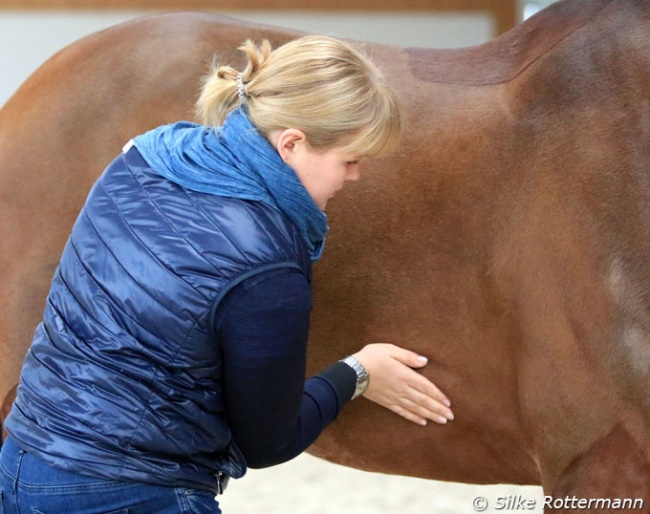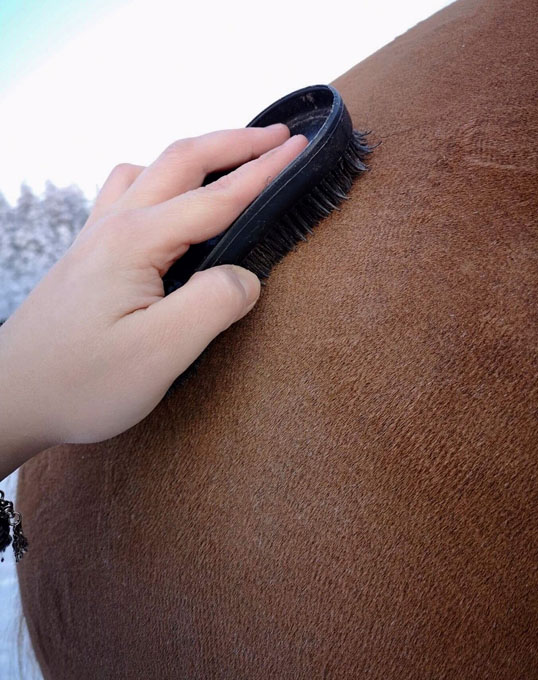
Does your horse’s skin move easily to different directions? You may groom your horse on a daily basis before and after his training without ever having paid to this detail which reveals a lot about our horse’s physical state.
If you glide over your horse’s hindquarters with your fingers, the way the skin moves (or gets stuck) under the slight pressure you apply gives you some useful indications about the fascia there. On some horses the skin on hindquarters may feel tense, and it may feel tight or stuck only to one specific direction. This same phenomenon can occur in different areas of the horses body, and there is a lot of individual variation for different reasons. Tightness or restricted movement in superficial structures always has even a deeper effect and it can be a result of problems in deeper structures or function of different movement directions or cause daily habits. Problems and tightness in the trunk area will over time reflect to the limbs, endangering tendons and other structures. It can also work the other way (from down upwards) as everything works together (remember fascia is like a huge cobweb in the horse’s body). If the horse is stressed and moving with tension or in a bad posture, the movement between the skin, the superficial and deeper layers starts to get disturbed, and the effects of this may reflect even far away in the body. Tension can happen for many reasons, it can be mental or physical, or the horse may be avoiding pain somewhere in the body which again starts to change the movement patterns of the horse. Even immobility (like standing a too long time in the stable) creates different problems, it may cause the skin to start to attach in structures below and restrict the movement even more.
With time and having the problems still going on, the structures will start to build attachments, the layers start drying out and get glued to each other, which will then disturb the proprioception and message forwarding in the body. To correct this, the overall wellbeing needs to be in the focus, so that the horse drinks, eats and moves well with equipment fitting to that horse. But these essentials will only happen in a satisfying way if the horse feels comfortable in his environment and there we have to remember that every horse is a moving and social animal. With good horse keeping and proper variable training we can avoid that fascia structures dry out, get stuck, cause physical trouble and therefore affect the horse’s ability. But it is the same “ingredients” plus facia treatment which then helps the function of the body to get back to normal.
However, in some cases it is the equipment which causes the damage. Something which needs as careful consideration as choosing the right saddle is the choice of a short dressage girth which is now so usual for most of the dressage saddles. Nowadays they come in many different shapes and more or less conventional constructions, most with elastic is some way, less without.

Now the horses will soon start to change their coat, from winter to summer fur, and the curry comb (may it be of plastic or steel) gets really useful to help the horse to get rid of the winter hair. It is should become a good and beneficial daily routine for you when grooming your horse to use the curry comb or any kind of massage glove with a soft, round, rubbing movement to move the skin easily to different directions. Do not be afraid: In different parts of your horse’s body the skin will move a bit differently, and this is a useful information for you as the owner or rider to know how the body of the horse usually feels. If the skin is sticking fast and is tight on some areas and the do it yourself – moving of the skin is not improving the situation, it is good to have a talk with your own veterinary physiotherapist to prevent problems already in an early phase. If you suspect the horse may have an issue with his overall health, then it is time to talk to a veterinarian.
by Niina Kirjorinne and Silke Rottermann
Related Links
Functionality in Equitation: Fascia and Movement
Meet Niina Kirjorinne, Classical Dressage Rider and Physiotherapist
Effect of Noseband Positioning to Fascial and Neural Dynamics of the Head